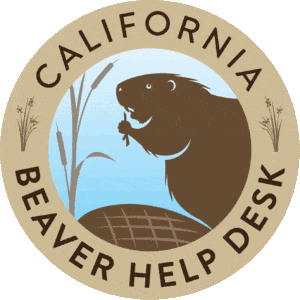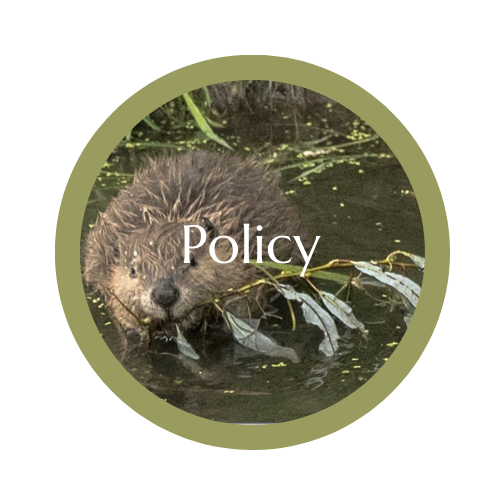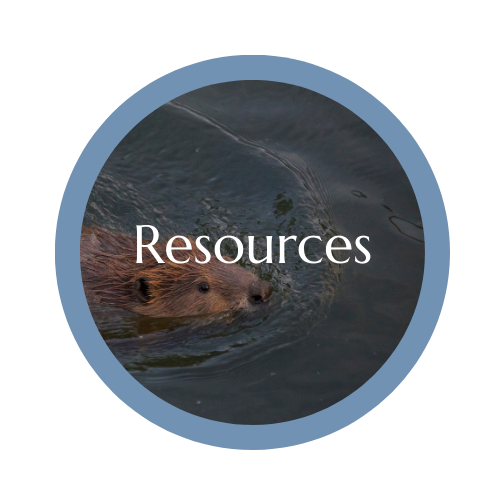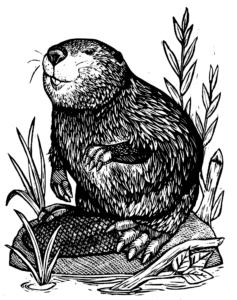Got Beaver Problems?
While some landowners appreciate the presence of beaver for a multitude of reasons, others are frustrated by what beaver do to the landscape. Here are some resources for mitigating human—beaver conflict.
The California Beaver Help Desk
Makes Coexistence Easy
Living alongside beaver can bring benefits and challenges. The California Beaver Help Desk provides technical support, financial assistance, and training opportunities that turn beaver problems into beaver solutions!
If you are experiencing human-beaver conflict or would like to become a Certified Beaver Coexistence Professional through the BeaverCorps, please visit the California Beaver Help Desk.


Coexistence Solutions
The most common complaints regarding “problem beaver” are about dam-building in streams or blocking culverts, irrigation ditches, or water conveyance structures, causing flooding and/or disruption of flow. Beaver also burrow into levees and dam walls and cut down trees and other valuable vegetation. Most of these activities can be managed with low-cost, easy-to-install strategies that prevent property damage and avoid the need to kill beaver while retaining the many benefits beaver bring.
Here’s how to manage some of these common problems:
As beaver build dams, the rising water can cause flooding. Attempting to notch and/or remove dams is an ineffective response as beavers will typically attempt to rebuild. Additionally, these activities encourage the beaver to harvest more vegetation, causing greater impacts on the riparian habitat.
To manage water height, property owners can build or install a flow control device. This device prevents a beaver’s dam-building behavioral cue—the sound and feel of running water. Because beaver have an instinct to build when they hear running water, it is a losing battle to simply remove their dam. Instead, putting a pipe through the dam prevents water from noisily spilling over the top, which discourages the beaver from building the dam any higher. A welded wire cage around the submerged upstream inlet keeps beaver from blocking the pipe. The pipe releases water below the dam crest on the downstream side, reducing dam-building cues. The installer can then lower the pond to the level that reduces flooding, ideally while retaining the beaver and their associated benefits.
For more information, visit The Beaver Institute’s page on dam flooding.
When culverts are installed in waterways in their habitat, beaver will often block the flow of water through the culvert. There are several strategies to prevent blocked culverts:
- Trapezoidal fence: An easy way to prevent beaver from blocking the culvert is to build a trapezoidal-shaped fence that is narrowest at the culvert and widens upstream. This forces the beaver to dam a much larger area, and as the dam grows along the fence, it gets farther and farther from the stimulus of water rushing to the culvert. Keeping the culvert open this way prevents the roadbed from becoming oversaturated or the road from washing away completely. A pond leveler pipe can also be run through the fence if needed.
- Fence and pipe device: This device is the same as a pond leveler.
- Starter dam: A starter dam can be built with fencing or natural materials such as rocks, wooden posts, and branches. Starting a dam 10 to 15 feet upstream of the culvert encourages the beaver to build on the starter dam instead of the culvert.
For more information, visit The Beaver Institute’s page on blocked culverts and drains.
The Beaver Back Saver eliminates the need to constantly clear twin-track weirs of debris from beaver activity. The retrofit slides onto an existing weir, drawing water through a perforated pipe capped with a metal grate, allowing the weir to convey water without beaver hearing or sensing the flow, thus deterring them from plugging it up. For more information and a how-to, see our Beaver Back Saver project.
Trees can be protected either individually or in groups. In most places, wrapping trees with a four-foot-high (two-inch by four-inch) galvanized welded wire is sufficient. Make sure the wire completely surrounds the tree and leave a 12-inch space all the way around the tree to allow for growth. In areas where it snows, using taller fencing that will reach about three feet above the average snow height is important to ensure year-round protection. Chicken wire is not strong enough to withstand beaver chewing. Some people use one or two strands of solar-powered, portable electric fencing set at beaver height to prevent them from accessing vegetation.
Another option for tree protection is to paint the tree trunks with a mixture of exterior latex paint and coarse sand. Paint does require more maintenance and reapplication, but can be color-matched to the tree bark to blend in well and address aesthetic concerns. To every gallon of paint, add 20 ounces of mason sand (30-70 mesh). Mix well and make only what you can use. Remove debris from the tree bark before applying the paint, and be careful not to apply too thickly or the sandy paint will roll off. Cover the entire section of the trunk that runs from the ground level to three feet above the anticipated snow level.

CDFW Policies and Permits
Relocation involves trapping live beaver from places where coexistence methods have been exhausted and reintroducing them into suitable locations. Due to reduced chances of survival in relocation, beaver should only be relocated from places where lethal management in response to damage would otherwise be unavoidable. The California Department of Fish and Wildlife (CDFW) is the only entity allowed to legally carry out beaver relocations.
Lethal management should only be considered the last resort, as it can cause bad public relations and be costly and ineffectual in the long run. No matter how many beaver you kill, if the habitat is favorable and there are other colonies nearby, they will continue to return. Recognizing the ecological and economic value of keeping beaver in place, the CDFW instituted a new policy in 2023 that supports non-lethal strategies when possible. It also considers the impact beaver removal could have on endangered species. However, the beaver dam removal is beyond the scope of its policy at this time.
Please visit the CDFW website for details on relocation and depredation permits:

Resources
Got problem beaver on the land you manage? Financial assistance is available for coexistence, and there are professionals who can help you find solutions!
- Financial Assistance Opportunities for Implementation of Non-Lethal Beaver Damage Deterrents (California Department of Fish and Wildlife)
- The Beaver Institute – management, research, and education
- Beaver Management Forum on Facebook
- Beaver Solutions – beaver coexistence in the US Northeast (MA)
- Check out LOTS more resources on our resources page!
Beaver Coexistence Training and Support Program–Contact Us!
The Occidental Arts & Ecology Center has been funded by the California Department of Fish and Wildlife’s Nature Based Solutions: Wetlands and Mountain Meadows Grant Program to create the California Beaver Coexistence Training and Support Program.
If you are experiencing conflict with beaver on the land you manage or would like to become a Certified Beaver Coexistence Professional through the BeaverCorps, please visit the California Beaver Help Desk.

Illustration by Fiona Barnacle





